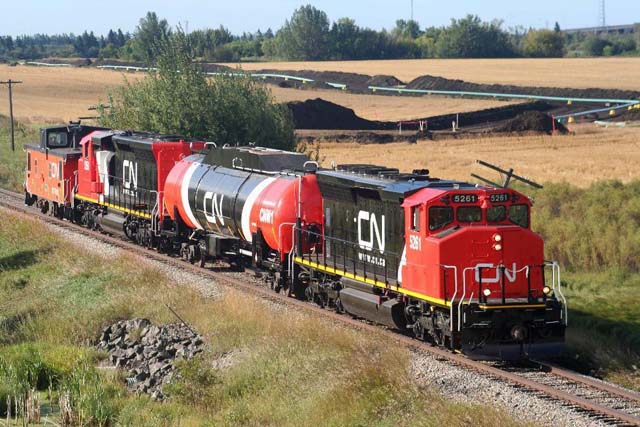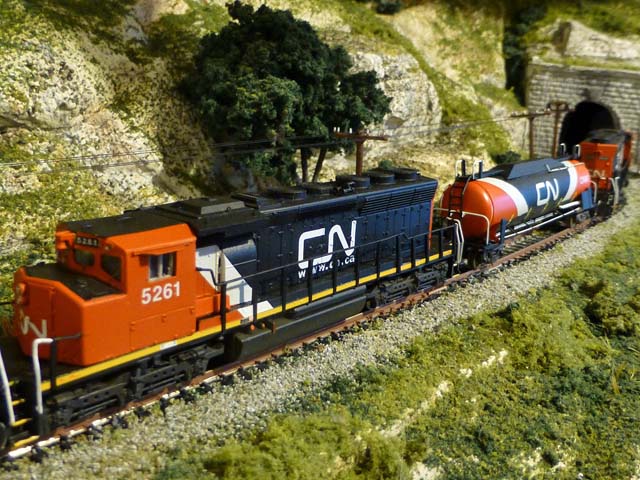|

|


Two Canadian National LNG (Liquefied Natural Gas) powered locomotives and fuel car - Date/Photographer unknown - Canadian National
Railway.
27 September 2013
Will LNG be a Railroad Game-Changer?
North America - Weighing the pros and cons of transitioning from diesel.
During the 1940s and 1950s, railroads embraced a new locomotive technology: diesel engines. Those that adopted early benefitted from the tremendous cost
levers diesel locomotion provided, including the ability to operate longer trains over longer distances, and the need for fewer locomotive, servicing, and
maintenance personnel. The mechanical and operational simplicity of diesel vs. steam was a key factor in the 53 percent decline in railroad employment numbers
from 1944 to 1965.
Jump to 2011, and the U.S. Class I rail carriers are spending US$11 billion annually for diesel fuel, this despite 15 years of aggressive improvements in fuel
consumption, and a resulting increase of 20 percent in gross ton-miles per gallon of fuel consumed. Today's fuel-efficient road locomotives utilize many
different technologies to reduce consumption, and even the low-horsepower switcher fleet has been optimized. Nevertheless, the railroads continue to look for
ways to reduce fuel consumption.
The desire to lessen the impact of railroads' most variable and unpredictable expense, at a run rate of US$30 million per day, has led to industry and investor
interest in what could be the next big upheaval in locomotive technology: the use of Liquefied Natural Gas (LNG) as an alternative fuel source. Recent
discussions in the industry press have considered the most obvious pros (fuel cost reduction) and cons (upfront investment requirements). But any move will
require much more in-depth strategic consideration, especially when it comes to the complexities of implementation.
Following are four areas that Oliver Wyman believes will be uppermost on the list for that analysis:
Increased Risk Profile vs. Diesel
How stable will LNG pricing be as market demand accelerates? What can be achieved through fuel hedging on a long-term basis? What impact will LNG substitution
have on diesel fuel pricing should it become a reality? Is the price of LNG on a horsepower-hour basis sufficiently cheaper to warrant heavy investment by rail
carriers? Will the cost advantage present today in 2013 be sustainable for 10 years, or 30?
Railroads typically expect a locomotive asset to remain in service for at least 15 years. A long service life helps justify the US$2 million spent for each new
road locomotive. Locomotives need to operate regularly to pay for themselves, so locomotive utilization must be stable and affordable enough so that there is
no apparent difference between today's diesel and tomorrow's LNG.
Because locomotives are currently equipped with only one fuel tank, how will a fleet transition from diesel to LNG work? Or, like the transition from steam to
diesel, will only new purchases be able to burn LNG fuel? How will the transition work from an operating standpoint? Having a mixed fleet, whether in
transition or just day-to-day, can create inefficiencies due to the complexities of networked rail operations.
Railroads are not like airlines: You cannot "reset" the network overnight or within 24 to 48 hours of a major network outage. The transition
from steam to diesel was generally conducted in phases. For many railroads, low-horsepower diesels were introduced in yard service, where their fuel supply was
readily available and the operating impacts could be easily assessed. Passenger trains were converted next, where steam locomotive changes at crew district
points could be eliminated in favor of longer-distance diesel operations across most or all of a passenger train route, with minimal refueling. Finally,
diesels were introduced to specific corridors to minimize operational disruptions, where generic "go anywhere" diesels supplanted special-duty steam
engines.
This phased approach is relevant for the application of LNG, where certain long-distance corridors might be the right answer for the transition to maximize the
advantage of fuel reduction.
Fleet decisions must focus on risk mitigation. What is the long-term strategy for consumption when it comes to new builds? What is the best answer for
operations? What is the best answer for the railroad's fueling infrastructure? What is the best strategy to mitigate risk? Steam locomotives were replaced
wholesale with diesels. Replacement of the entire diesel fleet with LNG-fueled locomotives may be a deal-breaker for the Class I's, which have recently
invested heavily in modern locomotives, notably the AC-powered road fleet.
A switch to LNG could target road locomotives first. Local locomotives are typically captive to a yard or local geography, and therefore easier to transition
to alternative fuel sources (as learned from hybrids over the past 10 years). But local fuel consumption is widely eclipsed by road consumption. Road
locomotives consume large amounts of fuel running across networks at significantly higher average throttle positions, whereas local locomotives spend lots of
time starting and stopping as they switch cars and serve customers. There is more financial gain to be had over the road.
Another risk reduction option would be to make LNG locomotives "hybrid," where LNG is an option but not the standard fuel source. Then, if
locomotives were in an unusual fuel supply situation, the assets could still be fully utilized.
While the implementation of this technology is still being discussed, traditional diesel fuel will likely be on board LNG locomotives. Having a large enough
onboard diesel supply to overcome situations where LNG refueling is not present could be key to adoption by the Class I's.
Finally, according to the AAR (American Association of Railroads), some railroads are looking into jointly developing LNG. Such efforts could help ensure
industry-wide success in implementing a new fuel source.
New Operating Complexities Will be Introduced
Multiple strategies among rail operators may introduce further complexities. What if strategies between carriers are in conflict, and does it substantively
matter? For example, western carriers might prefer one locomotive strategy (such as locomotives with fuel tenders) due to their longer runs, while eastern
carriers might prefer a different strategy (both fuel tanks onboard) due to shorter runs with more frequent locomotive turns.
There may be other reasons for these preferences as well, from the standpoint of operations, financials, and accounting, and mechanical practices. Furthermore,
how will run-through operations work between railroads? What happens if one railroad converts its road fleet to LNG while a run-through partner does not? While
a locomotive could leave "railroad A" fully fueled, it is possible that the locomotive may run out of fuel on "railroad B" due to
re-routings, unforeseen delays, etc. It is possible that "railroad B" may not have the fueling infrastructure to fill the tank. Or, will the
lengthened time between fueling make this a moot point?
Tender cars will require new operational considerations. Tender "tank" cars that carry LNG are relatively easy to insert into a locomotive consist.
Are there operational considerations for these tenders? For instance: What happens if a tender is bad-ordered? This is different from setting out one
bad-ordered locomotive, because the entire locomotive set is now bad-ordered instead of just one locomotive. With one locomotive down, many trains can continue
onward in a crippled manner. If an entire locomotive set is bad-ordered for any reason, the operational costs of failure are considerably higher.
Are their safety risks and liabilities for putting a tender between or behind locomotives? LNG tests in the 1990s were experimental in nature, and operated on
lower-speed trains. Will tenders operate safely and reliably on today's 60-plus premium trains, which are the longest-distance trains on North American rail
networks?
Partial fleet conversion may be difficult to execute operationally on a consistent basis. Is it feasible to convert only part of a fleet to LNG? While large
railroads typically assign certain locomotive specifications to certain "captive" assignments, the fact is that they do not stay captive forever.
Captive locomotives get moved to other locations and assignments for many reasons. Additionally, captive locomotives are "stolen" in emergencies, for
seasonal traffic fluctuations, etc. What happens if an LNG locomotive is taken out of the normal LNG network? What about the downtime of the locomotive
repositioning back to the LNG network?
Capital Expenditure Requirements
How difficult will it be to develop a fueling infrastructure for LNG? Is there physical space for additional fuel supply lines and storage tanks at existing
locomotive fueling facilities? Locomotive facilities these days are usually hemmed in physically from years and years of developments and modifications. Also,
what about the time needed to create these new supply lines and holding tanks, and the disruption caused to operations to take tracks out of service should
supply lines need to be submerged? Given that LNG needs to be stored at cold temperatures and has a short usable storage life, how will LNG distribution be
handled? Once the infrastructure is created, how will railroads manage LNG consumption to eliminate waste yet supply enough fuel so locomotives won't need to
"wait" for fuel?
A network of local fueling trucks may be necessary for parts of the rail network. One of the levers the railroads have used to improve service to customers is
through fewer mechanical defects on trains. One source of mechanical defects is locomotive failures on line of road. To avoid an on-line locomotive failure due
to a fuel supply issue, will LNG fuel trucks be available locally if a locomotive runs out of fuel at a remote location, such as a stranding situation during a
blizzard, or, more simply if the locomotive is stopped at a station not on the LNG fueling network?
Influence of External Factors
Because railroads are increasingly under scrutiny as generators of carbon emissions, is LNG adoption an opportunity to overcome the carbon hurdles posed by
diesel particulates? Trucking sources are citing an 18 percent reduction in emissions from LNG. LNG could make railroads significant environmental stewards,
which would have multiple side benefits. It may also add even more power to the argument the industry has made publicly about the resource efficiency of
railroads (a train can move one ton of freight close to 500 miles on one gallon of diesel).
The trucking industry cost differential may provide an impetus for railroad investment. LNG has captured the interest of a growing number of long-haul trucking
companies. These firms are now investing capital to modify or purchase new tractors that are propelled by LNG. Truck-stop providers are on record about
building an LNG fueling network in the U.S. East and Midwest. If enough of the over-the-road trucking industry makes this change, will railroads face a market
share issue from declining trucking costs, especially on newly won intermodal routes?
Look Before You Leap
There is definite potential for LNG to be a major source of cost reduction for the railroads, but these savings will only come following significant up-front
investments. We do not believe that LNG will be the game-changer that the steam to diesel transition was, as it would not involve the fundamental change in
physical assets, cost structure, company organization, maintenance practices, and labor counts that marked the steam to diesel transition.
One last point about the steam to diesel move: It provided the railroad industry with the competitive edge it would need just a few years later, when the
first Interstate highways were completed and trucks began to siphon away business. Today, similar competitive dynamics exist, this time from long-haul truckers
changing their cost structures through LNG adoption.
David Lehlbach and Oliver Wyman.

Without real world considerations interfering this model railroader has been quick to adopt LNG locomotives - Date/Photographer
unknown.



Vancouver Island
British Columbia
Canada
|